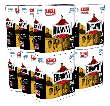Down bedding is luxurious and warm and worth every penny, however, it isn't without drawbacks. Unlike a conventional synthetic material filled duvet, you cannot simply pop it into the wash whenever it becomes dirty or musty. The down filling is comprised of the soft feathers of ducks and geese that grow directly under the tougher exterior feathers. Down is a lightweight and incredibly insulating bedding material that can be compressed easily. While the easy compression is great for storage, it also means that the feathers will be damaged if they are overly agitated in a washing machine and packed down in the dryer. Therefore, learning how to do it right the first time will save you frustration and money.
To Wash: Down comforters and pillows should be washed once a season if they are in use all year round. Begin by removing the comforter from the duvet cover and spot treating any stains or spots. Try not to use too much detergent or stain remover as it will strip the natural oils on the feathers and reduce the thermal properties of the down. Fill the washer with warm water and half of the recommended amount of gentle care laundry detergent, now place the comforter or pillow in the washing machine (an industrial grade machine is best, as it does not have an agitator. If using an industrial machine be certain to place five or more clean, prewashed, tennis balls in the washer along with the bedding). Placing five or more pre-washed tennis balls in with the comforter will help to prevent clumping of the down. The biggest concern with down bedding is preventing mildew or the formation of musty odors and as such you will want to give it a few extra spin cycles to remove as much water as possible.
To Dry: There are several options in drying your down comforter and pillow. The best option is to place it on an umbrella style drying rack outside in the sunshine. Sunlight kills dust mites and has natural bleaching properties. The fresh air circulating through the down will help to both dry the insulator as well as deodorize your bedding. Flip a few times over the course of the day and be prepared to shake it and redistribute the down into all of the boxed pouches of the comforter or pillow.
The second option is to use your dryer. You will want to remove as much of the water as possible prior to drying, so don't be afraid to spin cycle it several times and even manually wring some of the moisture out. Give the pillow or comforter a good shake and try to break up and redistribute any clumps that have formed before placing it in the dryer drum. Transfer the tennis balls from the washer into the dryer and feel free to triple the number of the balls. The balls will bounce and ricochet off the walls of the dryer drum and prevent the comforter from compacting into a tight wet ball. Set the dryer to the lowest heat or 'air dry' setting and continue restarting the cycle until all of the liquid has evaporated and the bedding is completely dry. Remove from dryer and shake well to redistribute any clumps and allow the comforter or pillow to hang dry for several days before storing or using to ensure that there isn't any residual moisture in the down.
If you care well for your down bedding, it should last you for at least a decade or longer. You don't have to spend a fortune on dry cleaning to enjoy the luxury of down and these tips apply equally to down jackets and clothing.

Tough Cleaning Jobs Require Brawny! Brawny paper towels provide the versatility you need: the strength for demanding jobs and the softness to clean up your child's messy face. This 24-roll pack of pick-a-size sheets can handle just about every cleaning task in your home. Check out Brawny 24-Pack Giant Paper Towels today!
One of the problems of a long winter is that bedrooms tend to become a tad stuffy and end up feeling claustrophobic. ...
Discover MoreIt's inevitable that you'll accrue a collection of sheets and pillowcases over your lifetime so you need a good way to ...
Discover MoreClosets are sometimes scary areas, and ones that need to be cleaned out regularly. If cleaning your closet freaks you out ...
Discover MoreFREE SERVICE: Get tips like this every week in Cleaning Tips from Tips.Net. Enter your address and click "Subscribe."
2023-04-18 10:55:10
J. Woolley
Here is a simpler version of the Tip's macro. It corrects a potential problem with MaxRow and does not require temporary use of column B.
Sub DryPeriod2()
Dim RowNum As Long, MaxRow As Long, AvDuration As Long, DryDur() As Long
MaxRow = Cells(Rows.Count, 1).End(xlUp).Row
With Range("A2:A" & MaxRow).Font
.ColorIndex = xlAutomatic
.Bold = False
End With
ReDim DryDur(1 To MaxRow)
For RowNum = 3 To MaxRow
If Cells(RowNum, 1) > "" Then
DryDur(RowNum) = Cells(RowNum, 1) - Cells(RowNum - 1, 1)
End If
Next RowNum
AvDuration = Application.WorksheetFunction.Average(DryDur)
For RowNum = 3 To MaxRow
If DryDur(RowNum) > AvDuration Then
Cells(RowNum, 1).Font.Color = vbRed
Cells(RowNum, 1).Font.Bold = True
End If
Next RowNum
End Sub
FREE SERVICE: Get tips like this every week in Cleaning Tips from Tips.Net. Enter your address and click "Subscribe."
Copyright © 2023 Sharon Parq Associates, Inc.
Comments